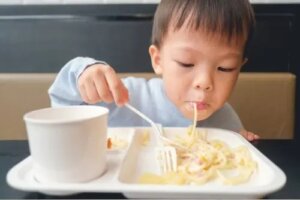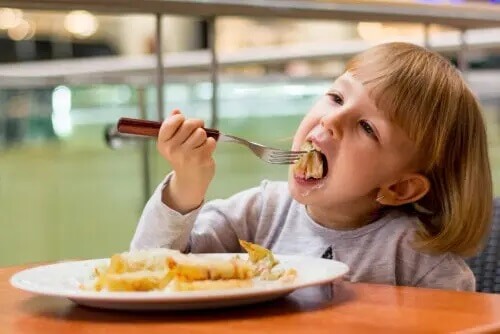Children's Menus: How They Affect Eating Habits

No matter where you go to eat, every restaurant and food chain has a special menu for children. But who determines what they have to put in their mouths? Today, we’ll talk about how children’s menus affect their eating habits.
Should children eat differently from adults?
If we did a survey asking about the dishes on children’s menus, 95-100% of people would know the answer with their eyes closed.
For one option, you’re likely to find spaghetti with tomato sauce. Or perhaps you may even have the possibility of ordering ravioli. Next on the list, you’ll see fried chicken fingers or nuggets, and probably a plate of macaroni and cheese.
For dessert, your little ones can pick between an ice cream sundae or some chocolate mousse. To drink, a soft drink or fruit juice. Rarely, do our kids ever choose water.
If you go to a fast-food chain, you’re likely to encounter pizza or a hamburger on the menu. They even use kids’ meal toys as a means to entice little eaters! This way, when they reach adulthood, they may associate that type of food with the prize without even realizing it. And, every time they reach a goal or feel bad, they’ll reward themselves or console themselves by getting fast food.

Is there a reason why it has to be this way? No, it’s simply because of the popular belief that children hate elaborate “grown-up” meals –especially if they contain vegetables.
Restaurants even establish their menus based on what they assume are children’s favorite dishes. However, children learn to eat by imitation and the influence of their family environment plays a major role.
It’s logical that, if we get them used to eating certain foods, they’ll opt for whatever’s the most similar. Therefore, we only manage to make their diet monotonous and unbalanced. To avoid falling into this trap, you should know some aspects to keep in mind about eating habits, as you’ll read below.
Teaching children to eat well without resorting to children’s menus
First of all, when introducing foods to children after breastfeeding, there’s usually an immediate refusal to try them. Generally speaking, this happens from the age of 2-3 years, especially in the case of bitter and acidic tastes.
On the other hand, they accept sweets. Why? Breast milk is sweet, so it’s pleasant for them. What’s more, they tend to accept the same food that their mother consumed during pregnancy and breastfeeding (if she chose this option).
Secondly, they need to eat each new food several times, at least 10 times, so that it becomes part of their regular diet. In addition, you should alternate between different textures and cooking methods, even combining new foods with foods they already like.
But avoid disguising foods so that they know how to recognize them. And, of course, try to present foods in a way that’s appealing.
And finally, we have genes related to the perception of flavors. How do they work? They influence whether we detect a certain flavor, especially bitterness, with greater intensity. Those who do are known as supertasters and reject it no matter how hard they try or how much flavoring they add to disguise it.
Taking into account all of the above, your child’s palate will be educated. So, if you want your children to eat vegetables and reject children’s menus, offer them different vegetables without forcing them to finish their plate. Why? Because if you force them, then the aversion they feel towards those foods will last a lifetime. We encourage you to do this with any food so that, when going to restaurants, they’ll make good choices without coercion.
Children’s menus: How they affect eating habits
After reading this, can you imagine the consequences of choosing children’s menus? Let’s look at them one by one.

What do they contribute at a nutritional level?
Children’s menus provide an excess of calories (400-500 kcal) that accumulate in the body if kids don’t get enough exercise. They contain too many refined carbohydrates, which give children energy. However, it’s better for them to consume whole-grain carbohydrates and only as a garnish.
They also contain sugars, whose consumption exceeds the daily dose recommended by the World Health Organization. What’s more, they provide them with fats, which increase cardiovascular risk.
How do they affect their growth and subsequent development?
It’s clear that frequent consumption of fried foods and foods rich in sugars and unhealthy fats will hinder their growth. At the same time, it increases the risk of developing type 2 diabetes, excess weight, obesity, and non-alcoholic fatty liver disease.
What’s more, it makes it difficult for them to grow sufficiently, since these foods are deficient in vitamins, minerals, and fiber, which affects their stool rhythm and increases the risk of suffering from cancer in the future.
It also impedes the proper development of their immune system and increases the risk of infections, colds, and flu. In turn, they’ll feel that they lack energy.
On children’s menus and eating habits
In short, if you want your children to enjoy life and grow up healthy, show them that they can eat just like you and that healthy food’s also good and attractive, besides the fact that children’s menus aren’t healthy.
No matter where you go to eat, every restaurant and food chain has a special menu for children. But who determines what they have to put in their mouths? Today, we’ll talk about how children’s menus affect their eating habits.
Should children eat differently from adults?
If we did a survey asking about the dishes on children’s menus, 95-100% of people would know the answer with their eyes closed.
For one option, you’re likely to find spaghetti with tomato sauce. Or perhaps you may even have the possibility of ordering ravioli. Next on the list, you’ll see fried chicken fingers or nuggets, and probably a plate of macaroni and cheese.
For dessert, your little ones can pick between an ice cream sundae or some chocolate mousse. To drink, a soft drink or fruit juice. Rarely, do our kids ever choose water.
If you go to a fast-food chain, you’re likely to encounter pizza or a hamburger on the menu. They even use kids’ meal toys as a means to entice little eaters! This way, when they reach adulthood, they may associate that type of food with the prize without even realizing it. And, every time they reach a goal or feel bad, they’ll reward themselves or console themselves by getting fast food.

Is there a reason why it has to be this way? No, it’s simply because of the popular belief that children hate elaborate “grown-up” meals –especially if they contain vegetables.
Restaurants even establish their menus based on what they assume are children’s favorite dishes. However, children learn to eat by imitation and the influence of their family environment plays a major role.
It’s logical that, if we get them used to eating certain foods, they’ll opt for whatever’s the most similar. Therefore, we only manage to make their diet monotonous and unbalanced. To avoid falling into this trap, you should know some aspects to keep in mind about eating habits, as you’ll read below.
Teaching children to eat well without resorting to children’s menus
First of all, when introducing foods to children after breastfeeding, there’s usually an immediate refusal to try them. Generally speaking, this happens from the age of 2-3 years, especially in the case of bitter and acidic tastes.
On the other hand, they accept sweets. Why? Breast milk is sweet, so it’s pleasant for them. What’s more, they tend to accept the same food that their mother consumed during pregnancy and breastfeeding (if she chose this option).
Secondly, they need to eat each new food several times, at least 10 times, so that it becomes part of their regular diet. In addition, you should alternate between different textures and cooking methods, even combining new foods with foods they already like.
But avoid disguising foods so that they know how to recognize them. And, of course, try to present foods in a way that’s appealing.
And finally, we have genes related to the perception of flavors. How do they work? They influence whether we detect a certain flavor, especially bitterness, with greater intensity. Those who do are known as supertasters and reject it no matter how hard they try or how much flavoring they add to disguise it.
Taking into account all of the above, your child’s palate will be educated. So, if you want your children to eat vegetables and reject children’s menus, offer them different vegetables without forcing them to finish their plate. Why? Because if you force them, then the aversion they feel towards those foods will last a lifetime. We encourage you to do this with any food so that, when going to restaurants, they’ll make good choices without coercion.
Children’s menus: How they affect eating habits
After reading this, can you imagine the consequences of choosing children’s menus? Let’s look at them one by one.

What do they contribute at a nutritional level?
Children’s menus provide an excess of calories (400-500 kcal) that accumulate in the body if kids don’t get enough exercise. They contain too many refined carbohydrates, which give children energy. However, it’s better for them to consume whole-grain carbohydrates and only as a garnish.
They also contain sugars, whose consumption exceeds the daily dose recommended by the World Health Organization. What’s more, they provide them with fats, which increase cardiovascular risk.
How do they affect their growth and subsequent development?
It’s clear that frequent consumption of fried foods and foods rich in sugars and unhealthy fats will hinder their growth. At the same time, it increases the risk of developing type 2 diabetes, excess weight, obesity, and non-alcoholic fatty liver disease.
What’s more, it makes it difficult for them to grow sufficiently, since these foods are deficient in vitamins, minerals, and fiber, which affects their stool rhythm and increases the risk of suffering from cancer in the future.
It also impedes the proper development of their immune system and increases the risk of infections, colds, and flu. In turn, they’ll feel that they lack energy.
On children’s menus and eating habits
In short, if you want your children to enjoy life and grow up healthy, show them that they can eat just like you and that healthy food’s also good and attractive, besides the fact that children’s menus aren’t healthy.
All cited sources were thoroughly reviewed by our team to ensure their quality, reliability, currency, and validity. The bibliography of this article was considered reliable and of academic or scientific accuracy.
- La Vanguardia. (2019) Razones por las que el menú infantil debería desparecer. [Consultado el 13 de mayo de 2020] Disponible en: https://www.lavanguardia.com/comer/tendencias/20190419/461708292611/menu-infantil-alimentacion-saludable-ninos.html
- ABC (2020) «El menú infantil no existe: es para que los niños ‘no den guerra’ en el restaurante» [Consultado el 13 de mayo de 2020] Disponible en: https://www.abc.es/familia/vida-sana/abci-menu-infantil-no-existe-para-ninos-no-guerra-restaurante-202001220123_video.html
- El Comidista (2015). Pataletas Contra el Menú Infantil. [Consultado el 13 de mayo de 2020] Disponible en: https://elcomidista.elpais.com/elcomidista/2015/11/04/articulo/1446677389_691659.html
- McDonalds. Happy Meal. [Consultado el 13 de mayo de 2020] Disponible en: https://www.mcdonalds.com/us/es-us/full-menu/happy-meal.html
- Telepizza. Nuestro menú infantil. [Consultado el 13 de mayo de 2020] Disponible en: https://www.telepizza.es/info/menusinfantil
This text is provided for informational purposes only and does not replace consultation with a professional. If in doubt, consult your specialist.








